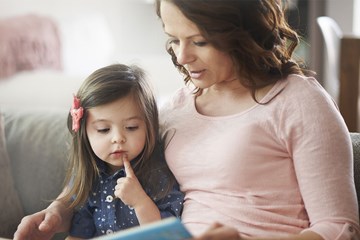How to teach a child to read
Teaching your child to read? This covers the importance of sharing books and building habits.
"You can find magic wherever you look. Sit back and relax, all you need is a book." Dr Seuss
Helping children learn to read is one of the most exciting, stimulating, wonderful times in a parent or carer’s life!
Watching them go from sitting there listening to your every word to now enjoying actively reading books to themselves is an honour and a pleasure of parenting. And the great news is that it starts with sharing books and building habits.

So, we thought about the most important aspects to helping a child to read and decided to release a blog about it.
We are focusing on children of all ages and how to develop a passion for reading through building life-long habits.
Daily story time doesn't have to be formal! It can happen at any part of the day, anywhere using a wide range of books with children. Squishy books, noisy books, board books, books with a story, books with pictures, an encyclopaedia, magazine, newspaper - anything counts!
The first step in helping them to read is to understand what you say as you read. Helping children to read starts from seeing you model how it’s done – funny voices, laughing and pointing out interesting things to spot!

Part of learning to read is understanding what has been read.
Making time for discussion is just as important as either reading to your child or listening to them read. You can discuss the pictures, ask them questions about what is happening or explore the feelings of characters.
What is the cat doing? Why is he doing that? Can you find the moment where Charlie realised he was lost?
I remember flicking through the pages of Green Eggs and Ham by Dr Seuss at around 3 years old - it had odd, pale colours and looked very unusual. I decided to put it back and look for something else...

Then my Dad read it to me with humour, pauses, fast and breathless pages.
And all of a sudden, re-reading this book became a daily occurence. You can still share stimulating books with your children whether they are not yet a reader, still building their fluency, or reading longer texts to themselves! Research demonstrates how this develops children's positive attitudes to reading - and can help to grow stronger bonds between you too.
Learning to read is something you can do without even a book in sight (!)
Reading skills such as developing their vocabulary, making links between books and remembering key points from stories can take place at the bus stop, in the car on long journeys or even when completing the weekly shop!
Why not try knock knock...who is it?
Player A: Knock knock.
Player B: Who is it?
Player A: I have magical powers...I go to school at Hogwarts...
Player B: Harry Potter?!
Player A: Oh so close! ...and I am best friends with Harry Potter...
Player B: Ron Weasley?!
Player A: Correct, your turn!
by Betsy Maytham
Published on 26 April 2019